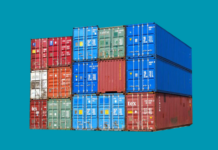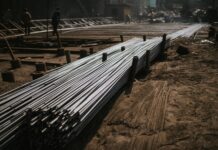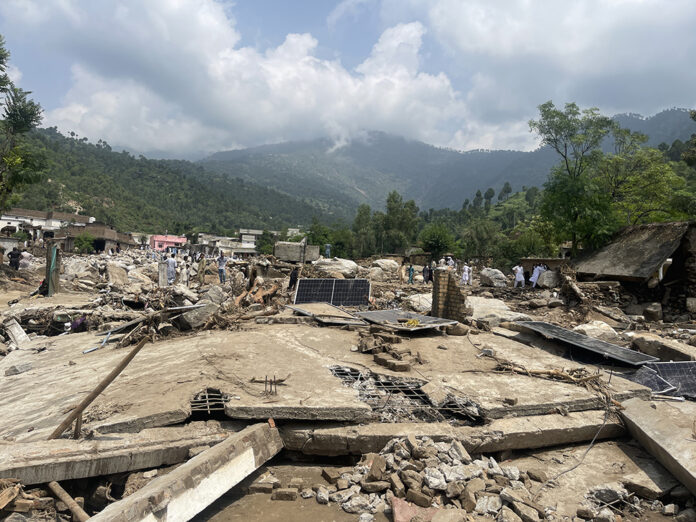Buner/Lahore/Hafizabad: The night before flash floods came barreling down into Buner, some in the small district thought the end of times had arrived. The thunder that preceded the chaos was deafening. Children complained of ringing ears as more than 150 mm of rain fell over the small district in Khyber Pakhtunkhwa.
The terrifying sounds of rain and thunder were only the beginning.
In 48 hours, more than 200 people in Buner were dead. Another 120 were injured and at least 50 more were missing. What happened in Buner was a rare natural occurrence known as a cloud burst. This type of event is when more than 100 mm of rain falls in an area in a time frame of one hour. In Buner the amount of water that fell in one hour was 150 mm.
It is confusing to measure liquid in units of length instead of volume. “One millimeter of rain” is actually one cubic millimeter per square millimeter. There is a long history to how the field of dimensional analysis arrived at this unit of measure as the best one for rain, but the simplest way to understand it is that “1 mm of rain” translates to one liter of water per square meter. That would mean 100 mm of rain would mean 100 litres of water per square meter.
A square meter is a square box roughly 3.3 feet by 3.3 feet. That means the cloud burst event in Buner meant 150 litres of water fell for every square meter in the space of an hour. Even as the catastrophic rain subsided, the sheer volume of water amalgamated in flash floods passing through the district. Massive boulders weighing thousands of kilograms came rolling into the valley, destroying homes, crops, roads, and anything else in their path. Entire trees were ripped out from their roots, turning into forces of mass destruction as they hurtled towards the district of over 10 lakh people.
More than 800 people have died in the floods that have hit Pakistan since early August this year. No single area has been hit harder than Buner. In the village of Bashonai Pir Baba, named so for the green-domed shrine of the 16th Century Sufi Pir buried there, Ashiq Ali looks on at what were once lush green maize fields. It is a bright sunny day with gentle white clouds drifting in the sky — no indication in the sky of the wrath it had unleashed on Bashonai only a few days ago. But one has only to look at the ground to see the wreckage.
Massive boulders have flattened the fields, blown entire houses away, and now it is impossible to move them. They are simply too heavy and the machinery required to get rid of them is simply not available.
But today Asghar Ali is worried about something else. The boulders that flattened his village also decimated the storage houses most families keep their wheat in. Buner is a subsistence based agrarian district. Families have small farms close to their homes and they grow staple crops such as wheat that last them the whole year.
“People here do not have large landholdings,” Ashiq Ali tells us. “They have just enough to grow enough wheat for the whole year. We use that to make flour and the germ to feed our animals. But our entire stores are gone now.”
The wheat stores are not the only problem. The local community can no longer grow any food because of the massive boulders that have taken over their agricultural land and made it barren.
“In the first few days the recovery from the flood was very difficult. People could not find the dead bodies of their loved ones and there were thick layers of mud everywhere,” says another farmer in Bashonai. “They had to bring in large excavators and other machinery to move the rocks and dig mass graves for the dead.”
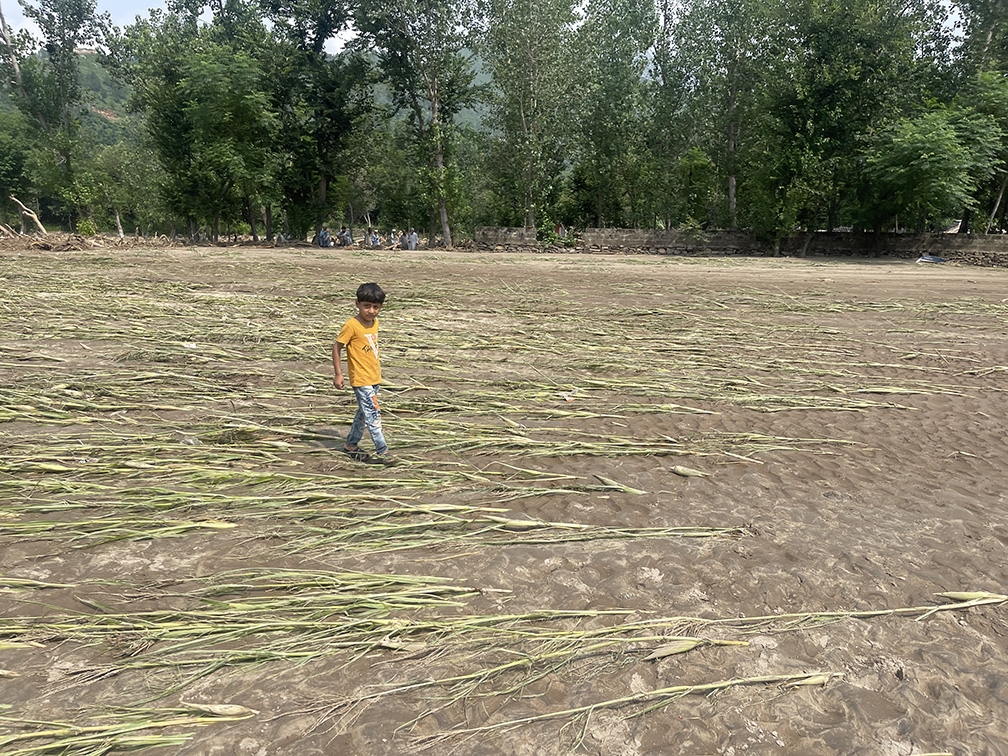
A child walks through his family’s flattened agricultural land in Buner following devastating floods
Now the survivors face a hunger crisis. With their wheat stores swept away, the residents of Buner and other flood affected areas all across KP had been hoping for relief and grain to come in from Punjab. For the first week or two after the floods which started around the 10th of August, wheat was coming in from Punjab. That has changed in the last 10 days. Since the floods hit Punjab around the 24th of August this year after India had to release water from its dams on the Ravi, Chenab, and Sutllej, the Punjab government through its different district administrations has blocked the supply of wheat from Punjab into KP.
While no official notification from the government has come through, Profit has seen notifications from at least a dozen districts calling for inspection of trucks carrying wheat to the Northern parts of the country. As a result, trucks full of wheat are waiting in long lines at checkpoints to enter KP and not being allowed to go through, with authorities in KP and transporters claiming each truck is being asked to pay a bribe of Rs 1.5 lakh to get their truck through. As a result, the price of wheat in KP has skyrocketed in mere days.
As the floods continue to travel South and evacuations run rampant in Sindh, Buner has become a political flashpoint. The response time of the National Disaster Management Authority (NDMA) in Buner became the subject of a heated debate between PTI Chairman Barrister Gohar Ali Khan and Law Minister Azam Tarrar on Friday.

“I say at this forum that we will continue to be at odds with the NDMA,” Barrister Gohar said on the floor in a heated warning. “I said day-before-yesterday that the NDMA only gave us a few supplies in Buner, while 236 people have been killed, 120 are injured, and 1,470 shops and 875 homes have been destroyed.”
A flood by another name?
Din Muhammad sat perched on his charpai as it rested slightly tilted on a small mound of dirt. Cars whizzed past him barely a dozen feet away. The traffic on the M2 was subdued early in the morning and offered little distraction to Din and the long line of people that found themselves camped out on the side of the highway with their families, cattle, and whatever belongings they could carry with them.
“People from the government came two nights ago and told us to evacuate. Some people from within the village did not want to leave and advised us against it but the government kept pushing. Eventually we grabbed our essentials and left,” he explains. His eyes are fixated on the scene in the distance. Right next to the motorway’s Babu Sabu Interchange close to Thokar Niaz Baig, the main entry point to Lahore, one can see nothing but water from miles. From a distance the water seems timeless. Like it was never not there. But it does not take long to notice what is poking out of the water. Golden three-pronged street lamps and billboard with the half visible words “New Metro City Lahore”.
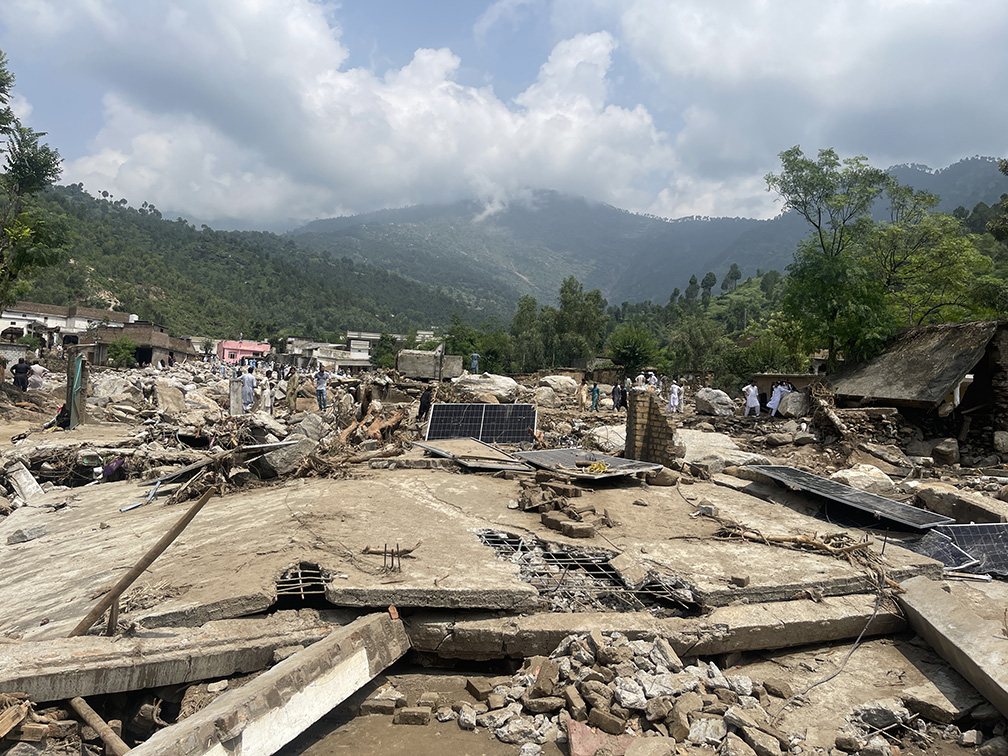
Massive boulders coming down with the flash floods in Buner did not discriminate between houses, fields, and infrastructure
“He is looking for our buffalo. When we left the village we brought all five animals with us, but it was night time and one of them wandered off in the middle and we haven’t seen her since,” his wife says from the foot of the charpai where she is attending to their children. “The buffalo we lost was the healthiest in our herd and gave the most milk. He’s worried we will never find her now.”
Just over a hundred kilometers away, Muhammad Azam is among the many in a relief camp set up by the Punjab Government at a public school. He sits on a makeshift floor outside tents that have been pitched on the school’s playground. Azam works at a hospital in Hafizabad City, but his family lives a little farther away where they have a couple acres of land that they use for their own needs. Azam had been home to look at his rice crop. “I grow Basmati here. It does not give me the best price but my family likes it and here in Hafizabad we have the best Basmati in all of Punjab,” he says. When the rains first arrived, Azam was hopeful it would mean a better harvest. But then they did not stop. Two days before the Chenab came hurtling towards his village, police officials had helped evacuate the village.
The experience of Muhammad Azam and Din Muhammad of this year’s floods was very different to the experience of Ashiq Ali and the many other families in Bashonai. Despite the destruction to farmland and property being massive, only 40 lives have been lost to the flooding in Punjab. As tragic as even these numbers are, the Punjab Government has been on top of the evacuation, rescue, and relief efforts. The Flood Forecasting Department has given timely warnings and the government machinery has stepped in quickly to minimise loss of life and provide relief to the more than 20 lakh people displaced by the floods and the countless more that have been affected by them.
The KP government’s response in comparison has been meek. Heroic stories have come through from the Northern Areas. In Gilgit Baltistan, three shepherds saved hundreds by warning their villages in time of an incoming flash flood. In Ashiq Ali’s hometown of Bashonai, a schoolteacher and volunteer, Zahoor Rehman rushed to help his community. He guided women and children to safety and carried several, including three young brothers, through debris-filled waters.
But as the flood intensified, Zahoor was struck by a massive boulder while trying to help a guest. His last words were: “I’m going. Don’t come in!” Moments later, the waters swept him away. His body was found two kilometers downstream.
The stories of individual heroism aside, the government has appeared quite helpless. There have been no early evacuations and relief efforts have been slow. When KP Chief Minister Ali Amin Gandapur visited Buner, for example, he said quite curtly that his government was “trying” and they could not “bring the dead back to life.” One reason for this, of course, is that the situations in Punjab and KP are not comparable. “What you have in KP is a very different phenomenon. It is a combination of flash floods from glacial lakes melting in the Himalayas and repeated cloud bursts because of climate change,” says Dr Hasan Abbas, Pakistan’s leading hydrologist and river expert.
“In Punjab you have river floods. These take place because of heavy monsoon rains particularly in India where there has been a lot of rain that has led to the dams on the rivers Ravi, Chenab, and Sutlej filling to capacity and forcing India to open their gates. As a result the rivers flood everything in their path both in the Indian and Pakistani sides of Punjab.”
As Dr Abbas explains it, the situation in KP is the result of climate related chaos. Glacial Lake Overflow Floods (GLOFs) take place when a retreating glacier melts and releases a great cache of water which hurtles down the high mountains causing destruction in its path. Similarly, cloud bursts, even though they sound like a cloud popping like a balloon, is when an area is hit by a large quantity of rain in very little time.

In the case of KP, forecasting these events is comparatively more difficult. The impact of climate related GLOFs and cloud bursts is sudden. What is needed is a robust alarm system, weather prediction services, and most importantly community engagement. “If you give people full time employment, station them at important points, and give them communication capability at a community level that alone can be enough to save many lives,” says Dr Abbas.
In Punjab, the flood forecasting department knows the natural course of the river, has live data regarding how much water is coming at any given time and can estimate how long it will take this water. A big problem in the case of Punjab has been the building of infrastructure on the embankments of Punjab’s rivers, particularly on the Ravi near Lahore. It has been the subject of another story by Profit.
Read more: The crimes of Punjab’s real estate barons are drowning us
Damage abound
The common ground between KP, Punjab, and eventually Sindh will be the decimation of agriculture in all of these flood affected districts. In Punjab, more than 4000 villages have become inundated with flood water. Put that into perspective: the last time Punjab conducted a Mouza/Village census was in 2020. Back then the government reported there were a total of 26,462 villages in Punjab. That means nearly 20% of the villages in Punjab and their accompanying agricultural lands have been hit by these floods.
In Punjab, the current season is Kharif, which means most of Central and North Punjab close to the river regions have been used for rice cultivation. A number of alarmist calculations have come up in recent days claiming nearly 60% of the rice crop has been destroyed. In reality, rice is very good at absorbing water and there is no knowing how much will be destroyed until the floods clear out.
As far as food security is concerned, the situation of the current rice crop is not threatening. The total area under rice cultivation in 2024 was 10.6 million acres, which makes it 12.9% of the total cropped area. As a percentage, this is down from 2010 when rice was grown on 9.36 million acres, making it 14% of the total cropped area. Overall the area that is under rice cultivation has not increased by much. Rice has actually seen an improvement in yield. In 2010, the total rice production was 11.1 million tonnes accounting for 1.18 tonnes per acre. In 2024, the total production was 14.7 million tonnes giving an overall yield of 1.38 tonnes per acre.
The bigger concern is wheat. It is the single largest caloric component in the diet of the average Pakistani. Wheat makes up nearly a third of the caloric intake by an average Pakistani, and Pakistan’s per capita consumption of wheat is 124 kilograms annually, which is the highest in the world.
While these floods did not come in the Rabi season, what we do know is that a lot of the soil in Punjab could become waterlogged, which means when it is time for the Rabi season and the wheat crop, it might not be viable.
In 2024, wheat accounted for 43.3% of the total cropped (GSA) area of 82.7 million hectares. That means wheat was grown on just over 35 million acres. Since wheat is only grown once per season, that means it is grown on 35 million acres out of the total cultivated area of 52.7 million, making it a crop grown on more than half the cultivated land in the country in 2024. In 2023-24, the total production of wheat in Pakistan was 31.58 million tonnes grown on around 35 million acres.
In KP as well the damage has been extensive. According to data collected by Profit through government sources, there are 3.16 lakh acres of land where crops are being grown that have been completely destroyed. The most extensive damage has been to the maize crop, which is a major contributor to KP’s economy. Much like Punjab, this also accounts for close to 15% of the total cropped area in KP. That, of course, is the destruction of the existing crop. It will impact farming families in the long run, but the immediate concern, of course, is that there is no wheat in the province.
A time for unity
All across Punjab, government officers have been appointed to stand watch at different exit points from the province. The notifications for their duty, announced by different district governments and not a central order from the Punjab government, lists the nearly 60 exit points and assigns 120 officers to monitor them. An officer is present 24/7 with the first one there from 9 AM to 9 PM and the next officer on the night shift from 9PM to 9AM. Their appointment in these notifications have explicitly been made to “monitor the movement of wheat and wheat products including flour to other provinces.”
Sarhad Chamber of Commerce and Industry President Fazal Moqeem Khan and Pakistan Flour Mills Association KP Chairman Naeem Butt addressed a crowded joint news conference at chamber house on Tuesday, blaming the Punjab Government and top bureaucrats for halting supply of wheat to Khyber Pakhtunkhwa with nexus of mafia, described the ban was sheer violation of article 151 of the constitution of the country. According to them, KP is facing a shortfall of 41,000 metric tons of wheat as the province’s total wheat production is 12,000 metric tons against its demand of 51,000 metric tons. On top of this, in areas like Buner where families often produce 40 to 70 maunds which is enough for their own families at least, the storage houses for this wheat have been swept away.
“The worst part about this is that the Punjab government has not shared any official decision to stop wheat from coming to KP during this time. That is because it would go against Article 151 of the Constitution,” says Mansoor Khan, the General Secretary of the KP Flour Mills Association. “That is why they only issue orders through the bureaucrats of the district administration because otherwise Lahore would be exposed to constitutional litigation.”
What he is referring to is the article that ensures inter provincial trade. Article 151 is quite clear. It says “commerce and intercourse throughout Pakistan shall be free.” The only provision it makes for a disruption in free trade between provinces is if the federal government through an act of parliament creates a new law that would restrict such movement. Not only this, but the constitution goes on to specifically barred provincial governments from legislating on the issue or imposing any kinds of tolls, taxes, or fines on provincial trade.
“We do have documentation regarding newly established checkpoints that are restricting movement,” said Fazal Muqeem Khan, the President of the association. He described it as a “deliberate blockade,” accusing them of colluding with a “well-organized mafia.” According to them, after enforcement orders were issued on August 26 under the directive of the Punjab Chief Secretary, specialized checkpoints were swiftly set up to prevent wheat-laden trucks from entering KP. This, they argue, constitutes a form of “economic terrorism” against a province already grappling with a major wheat deficit and heavily reliant on supplies from Punjab and the open market.
On the ground Profit witnessed the lines of trucks waiting to be let into the province. More concerning are accusations of widespread corruption. Unofficial checkpoints are reportedly charging truck drivers bribes of up to Rs 1.5 lakh per vehicle—without any official receipt or documentation—creating an underground economy fueled by state-backed barriers to trade.
The unfolding crisis not only exposes the vulnerabilities in Pakistan’s inter-provincial trade mechanisms but also raises serious constitutional and economic concerns about central-provincial coordination and the sanctity of free trade within the federation. For the people of Buner, who have suffered the most in this year’s climate catastrophe, it means they do not know what they will eat tomorrow. Their worries about the future are on hold because for them, the food crisis from these floods has already hit.


